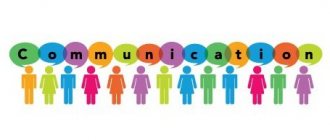Communication is a complex socio-psychological process of establishing and developing contacts between people, generated by the needs for joint activities and including the exchange of information, the development of a strategy for interaction, perception and understanding of a partner.
Socially, it acts as a means of transmitting human culture and experience. Its specificity lies in the fact that the interlocutors reveal their subjective world to one another and show individual characteristics.
Communication varies according to:
- Number of participants: interpersonal, group, mass;
- Method: verbal (language, speech), non-verbal (facial expressions, gestures);
- Position of those communicating: contact (personal), remote (for example, through the media);
- Conditions: official (organized meetings), informal (on your own initiative);
- Tasks: installation (for the purpose of getting to know each other), informational (messaging);
- Means: direct (hand, head, voice sounds), indirect (trace, radio, television), direct (the ability to see, hear, feel), indirect (through intermediaries).
Types of social communication
There are different classifications of social communication.
Depending on the means of presenting information, communication can be verbal and non-verbal .
Depending on the number of participants:
- interpersonal (interpersonal);
- massive.
According to style, direct and indirect communication are distinguished.
Purpose of the message:
- educational;
- suggestive;
- expressive;
- ritual;
- persuasive.
According to the form of the communicative event:
- phone conversation;
- meeting;
- rally;
- public speaking;
- lecture.
Communication channels adequate to the senses:
- Visual;
- Auditory;
- Tactile (touch);
- Somatosensory (kinesthetic, feeling your body).
People have characteristics in the perception of the outside world and another person (social perception). They are divided into visual, auditory, and kinesthetic learners:
- visual people – they prefer to see everything with their own eyes, they like to tower over their partner;
- auditory - perceive reality through auditory images: music, speech, sounds;
- kinesthetics – experience (emotionally) through the state of their body.
Logically, we can name the following communication channels: direct, indirect, controlled indirect:
- direct channel – transmission of information in explicit form;
- indirect (indirect) – information obtained for the purpose of control or addition to what was previously accepted;
- controlled indirect channel - a message perceived as unintentional is presented as completely intentional (a convincing tone in a dubious situation).
Means of communication:
- Language is a system of words, expressions and rules for combining them into logical speech;
- Intonation is emotional expressiveness that can give a different shade to any phrase;
- Facial expressions, posture, gaze - can enhance or refute the meaning of what was said;
- Gestures – generally accepted or expressive (for expressiveness);
- The distance of the interlocutors depends on the degree of their trust, cultural and national traditions.
In speech, tempo, volume, and intonation are distinguished, which makes it possible to determine the emotional state of the individual and his attitude to the transmitted message.
A person cannot consciously control the entire sphere of means of communication for a long time. Therefore, often even what he wants to hide is revealed, for example, through the movement of his hands, the expression of his eyes, the position of his legs, etc.
Communication strategy:
- Open - closed (Closed communication - the reluctance or inability of one of the partners to clearly convey their point of view, information);
- Monological - dialogical;
- Role-playing (social-role-playing) – personal (“heart-to-heart”).
An important issue in communication is openness, i.e. not only the sincerity of the speaker, but also the ability to perceive the partner impartially. High culture gives you confidence that you will be understood correctly.
Communication tactics is the implementation of a strategy in a specific situation based on knowledge and mastery of techniques, rules and techniques of communication.
Types of communication:
- Mask contact (formal communication) – lack of desire to understand the partner, to take into account his individual characteristics. The usual cliches are used (politeness, severity, compassion, equanimity, etc.), artificial facial expressions, gestures, a set of phrases, which allows you to hide the true attitude towards the interlocutor;
- Primitive communication - a person is evaluated based on his usefulness. Needed - they will actively make contact, interferes - they will not notice, they get what they want - they will push them away;
- Formal-role-based, when both the content and means of communication are regulated, instead of studying the individual, they make do with knowledge of social (official) functions;
- Business communication – the individual’s psychological qualities, character traits, motives, and mood are taken into account. However, the interests of the case are higher and more significant than possible personal differences;
- Spiritual communication of friends - they can talk without words, using facial expressions, intonation, using gestures, movements;
- Manipulative communication – pursues one goal: to extract benefits from a partner using various techniques (revenge, intimidation, “showing off”, deception, demonstration of kindness, courtesy, etc.);
- Secular communication - its essence - is non-objective, i.e. people do not say what they think, but what is appropriate in some cases.
Communication functions
In psychology, there are many classifications of communication functions.
According to the criterion of the purpose of communication, eight functions are distinguished:
- contact – establishing a state of readiness to receive and transmit messages;
- informational – exchange of messages, information, plans;
- incentive – stimulation of subscriber activity;
- coordination – mutual coordination of actions;
- understanding – perception and understanding of the meaning of the message, attitudes, intentions;
- amotive – arousing the necessary emotional experiences in the interlocutor;
- establishing relationships - awareness of one’s place in the system of role, business, interpersonal connections of the team in which a person acts;
- exerting influence – changing the partner’s state and behavior, incl. his opinions, intentions, attitudes, needs, etc.
We will consider a generalized version - three functions (they are called sides, aspects) of communication:
- Communication (exchange of information);
- Interactive (organization of interaction);
- Perceptual (perception and formation of an image of another person).
Communicative function of communication.
Communication is a process of two-way exchange of information leading to mutual understanding (Communication (lat. communicatio) is an act of communication, a connection between two or more individuals based on mutual understanding; the communication of information by one person to another or a number of people.). In their activities, people exchange with each other various perceptions, ideas, interests, moods, etc. This is the information of human communication, which is not just sent, but also formed, clarified, and developed.
The communicative side of communication has its own specifics:
- Communication is not just the movement of information. Here we are dealing with a relationship between two individuals, and each of them acts as an active subject (their mutual information implies the establishment of joint activities). The significance of information is determined by the fact that it is not just accepted, but also meaningful and understood;
- The exchange of information involves mutual influence, psychological influence on the partner’s behavior in order to change it. In this case, participants must have a unified coding system, i.e. when the signs and their meanings are known;
- There may be barriers to communication. On the one hand, there is a lack of a common understanding of the current situation (social aspect); on the other hand, obstacles can be of a psychological nature due to personal characteristics (secrecy, mistrust, incompatibility, etc.).
Verbal and non-verbal means of communication
(Verbal (lat. verbalis) - verbal, oral.)
Verbal communication is oral and written speech, i.e. Language serves as a sign system. Its structure includes:
- The meaning and meaning of words, phrases;
- Speech sound phenomena (modulation of voice pitch - smooth, sharp; rhythm - uniform, choppy; timbre - rolling, hoarse, creaky; tonality - high, low; diction; intonation; speech rate - fast, medium, slow). They are studied by paralinguistics;
- Expressive qualities of the voice - specific sounds - laughter, grunting, crying, whispering, breathing; separating sounds - cough; zero - pauses, nasalizations - “hmm-hmm”, “uh”, etc. They are studied by extralinguistics.
Forms of oral speech – monologue and dialogue. Many factors influence the effectiveness of communication. Among them: intentions - moods, attitudes, suggesting active interaction between partners; their involvement in joint activities; the presence of feedback (allows you to reveal the accuracy of perception of the meaning of information); skills and abilities.
Although speech is a universal means of communication, it is complemented by the use of other sign systems. Scientists believe that in communication words make up 7%, sounds and intonations – 38%, non-verbal interaction – 53% (according to other sources, up to 80%).
Ways and means of communication
Work instructions - a message defining the job responsibilities of employees
7. Methods and means of communication
Information can be transmitted using signs or their entire system. The most common and “natural” is the transmission of information through speech - a system of verbal signs used in direct communication. Messages transmitted orally by a person are usually called verbal.
Non-verbal (non-speech) methods of transmitting information include facial expressions, gestures, posture, tempo and intonation of voice, spatial arrangement and distance during communication.
Let's consider each of these means of transmitting information in more detail.
Verbal means.
Experts distinguish four types of speech activity. Two of them - speaking and writing - relate to the creation of a message, and two - listening and reading - relate to the perception of the message. An effective manager must successfully carry out these activities.
Speaking. Most information is transmitted orally. Therefore, speaking skills are of great importance for a manager. It is obvious that the effectiveness of oral communication of information is determined not only by a good reaction, but also by clarity of thinking and the ability to clearly express one’s thoughts.
In the process of speaking, the communicator encodes information - selects the necessary words and phrases, intonation and manner of speech, and the recipient, listening, decodes it. Therefore, when communicating verbally, it is necessary to imagine how the interlocutor perceives your information (does he know the meaning of all the words you use, especially terms, does he keep up with your pace of speech, what meaning does he give to your intonation), and how he will react to it (offens whether your message affects his views and values, is important to him or indifferent).
It should be taken into account that an employee involved in the thick of ongoing events and emotionally experiencing them finds himself hostage to a phenomenon that in psychology is called “predisposition in favor of one’s own “I”.” It seems to the employee that what is clear to him is clear to everyone, so he thinks that his worries and experiences, successes and failures are obvious to the manager. In other words, he tends to overestimate the extent to which he is understood.
With all the variety of forms of activity in which oral communication can be used - speech, presentation, conversation, meeting, etc. — the main guarantee of effective communication is the ability to see oneself through the eyes of the interlocutor and, based on this, choose an adequate form of transmitting information.
Writing. Widely used in organizations in the practice of transmitting information, written communication has a number of advantages. When compiling it, a person has time to put his thoughts in order, think through several options for presenting information, and choose the one that most accurately conveys his position.
Written means of communication include: letters, instructions, information messages, reports, etc. In most cases, a written message requires the use of an official business style, which requires the utmost precision and unambiguity of statements, and therefore the accuracy of the information conveyed.
In relation to the written method of transmitting information in American business practice, the so-called KISS principle (from the English. Keep it short and simple) is popular. In practice, this means following three simple principles in business correspondence: keep your words shorter; fewer words; use pictures if possible. These principles seem extremely simple and obvious. However, their practical implementation requires serious practice and experience.
Hearing. Listening and hearing are two different things. If a person does not know how to listen, he can “miss the ears” a lot. Research shows that when a person listens to another, he tends to overestimate how accurately he perceives what he heard. It seems to him that everything is clear. As a result, he may listen to something very important, miss an advantageous offer, or mistake secondary information for the main one. A number of factors influence the fact that a person does not listen effectively to the interlocutor:
— firstly, the overabundance of information received during the day does not give a person the opportunity to treat all messages equally attentively;
- secondly, often a person’s own experiences and thoughts are more important than what others report, he is absorbed in his thoughts;
- thirdly, a person thinks faster than he speaks, so when listening there is time to think about something else that is more significant for a person than the interlocutor’s message;
- fourthly, a possible reason for poor receptivity may be dislike for the interlocutor, as a result of which a person may stop listening to him or misinterpret the essence of his message.
In order to overcome these problems, a person needs high concentration and self-control. It is important to maintain constant feedback with the interlocutor, using its various forms - repetition of what was said, clarification, retelling, which allows you to maintain or correct the conversation process. Listening attentively allows you not only to correctly understand the content of your interlocutor’s speech, but also to show respect for him. In response to your interest, he will also be attentive to your words. It should be remembered that people who like to talk, but do not like to listen, risk finding themselves without attentive interlocutors.
Reading. Today, employees of most organizations receive and process a huge number of documents - letters, faxes, electronic messages, internal documents (memos, etc.).
For many, this information deluge becomes a huge problem, negatively affecting not only the employee’s mood and well-being, but also the results of his work. This dictates the need to take appropriate measures both at the level of the enterprise as a whole and at the level of the organization of work of each employee.
Organizational efforts should be aimed primarily at streamlining the document flow. Serious work is required to organize document flow, since its absence is a factor that reduces the efficiency of the entire enterprise.
Each employee, along with following the general corporate rules for working with letters and documents, must determine his own principles for working with them. They should be based on the accuracy and timeliness of processing business papers.
Nonverbal means
Nonverbal means of communication perform various functions:
- they can illustrate what we communicate through speech, and be used as a type of “parallel” language that accompanies the speech of partners in the process of communication;
- act as regulators of communication - we can communicate through posture and facial expressions our interest or desire to stop communication;
- express our experiences; act as an independent signal.
Adaptive behavior can also be considered as means of nonverbal communication. These are movements that help the body adapt to the situation (scratching the nose, nodding the head). The interlocutor may attribute some meaning to these movements, although the person did not mean anything. Nonverbal language continues to operate even when we do not attach meaning to it. Often, a message in the language of facial expressions can be more meaningful than information conveyed in words. If you tell your interlocutor with tears in your eyes that everything is fine with you, then he is more likely to believe what he sees than what you say.
In non-verbal communication, special signs are used instead of words. When using the same sign systems, people will easily understand each other. Each nation has its own set of nonverbal means. When communicating with representatives of another culture, people may inadequately perceive their behavior by incorrectly “reading” the interlocutor’s message. For example, when communicating with the Japanese, Europeans often make a common mistake. The fact is that the Japanese often nod their heads and say the word “hey” when speaking. It is usually translated as “yes.” However, in the process of communication, the Japanese use this word as a speech regulator, informing the interlocutor that he is being listened to and understood. This is a kind of sign of politeness and respect for the interlocutor. Europeans, when conducting business negotiations, incorrectly interpret it as a sign of agreement.
Often, the interlocutor’s use of an incomprehensible or unusual system of nonverbal communication causes a negative emotional attitude. This is easily illustrated by the example of the distance that people use when communicating. If your interlocutor during communication is too close, in your opinion, approaches you or moves away too much, you will obviously experience inconvenience, and possibly irritation, although he did not want to cause you inconvenience. Thus, it is known that many peoples of southern Europe - Italians, Spaniards, Greeks - use a shorter distance when communicating than is customary in more northern countries, for example in Russia. And representatives of northern Europe - Finns, Swedes, Norwegians - prefer to conduct a conversation while being at a great distance from each other. In order to effectively use the language of nonverbal communication, it is necessary to take into account national and cultural differences, as well as the social and personal characteristics of people (age and socio-professional differences). For example, young people may understand certain gestures and facial expressions common among their peers, but they will say little or may be misinterpreted by representatives of other age groups. This also applies to non-verbal means used by representatives of different professions. Thus, not everyone may understand the gestures of builders or the signs of traffic controllers.
Communication will be more successful if a combination of verbal and non-verbal means of transmitting information is used.
8. Manager’s communicative competence
The complexities and problems that arise in transmitting and receiving information indicate that for a manager to be effective, it is extremely important that he has communicative competence.
The communicative competence of a manager is the possession of communication skills and abilities, knowledge of cultural norms, customs and etiquette, orientation in communicative techniques and means and the ability to use them adequately in a specific situation.
High communicative competence is characterized by the ability to predict a situation, the ability to “get used to” it and manage it. Its basis is the ability to self-regulate, when a person can create an emotional mood that is adequate to the situation, which also presupposes the ability to understand the partner’s state and express one’s own.
Communicative competence can be formed both in the process of a person’s direct acquisition of social experience from the practice of his own communication, observation of other people, perception of art and the media, and in the process of special training - psychological training. During the training process, participants interact with people demonstrating various models of professional activity, taking place against the background of significant motivational tension caused by the group nature of the work.
To create a highly realistic environment from a psychological point of view, business and role-playing games and special exercises are used. Every manager must constantly improve their communication competence. To this end, it is necessary to carefully analyze communication practices, find errors and outline measures to correct them. You should learn from the experience of colleagues who successfully carry out communicative activities, whose skills and abilities are harmonious and effective.
Conclusion
Communication plays a big role in the management process. Classification of communications is necessary to identify their various types for the purpose of subsequent analysis and improvement.
Information is one of the most important management tools. Analyzing and transmitting information, then receiving feedback signals, the manager plans, organizes, coordinates, motivates and controls subordinates, i.e. Every manager must be a communicator.
Communication refers to the exchange of ideas and information between people and their associations in the process of interaction, verbally and in writing through symbols or actions. At the same time, the transmitted information must be significant for the participants in the communication.
The purpose of communication is to ensure that the receiving party accurately understands the message sent. The effectiveness of management, the speed and accuracy of implementation of decisions made and the effectiveness of execution control largely depend on the reliability and timeliness of obtaining the necessary information.
The transfer of information in an organization can be hindered by rumors, personal relationships between people, distorted self-esteem of team members, the power of authority, or someone else's leadership.
Communications in an organization can be classified according to a number of criteria: by the subject and means of communication, by the form of communication, by the channel of communication, by their spatial location, by the direction of communication.
Among all types of communications for the study of organizational behavior, the most important role is played by interpersonal communications, which are influenced by factors such as feedback, competence of the sender and recipient, rights of the sender, trust of the recipient in the sender, compatibility of the recipient and the sender.
Interpersonal communications can be verbal and non-verbal, formal and informal. Nonverbal communication is an important source of information about the thoughts and feelings of the sender and receiver. Therefore, knowledge of nonverbal signals is so important for effective communication. Managers must develop the art of mastering and reading nonverbal communication cues.
Nonverbal communications complement verbal ones. Formal communications are determined by the organizational structure of the organization, which must clearly record the spatial location of communication channels and ensure the effectiveness of vertical, horizontal and diagonal communications.
Informal communications complement formal ones. Informal communications and rumors exist in any organization, being an integral part of its life. Information that passes through formal channels is rarely transmitted through them.
There can be various barriers to effective communication. Knowing possible barriers, managers should try to prevent their occurrence or look for and plan effective ways to overcome them.
Bibliography
1) Ashirov D.A., Organizational behavior. – M.: TK Velby “Prospekt”, 2006. – 262 p.
2) Bolshakov A.S., Mikhailov V.I. Modern management: theory and practice. - St. Petersburg: Peter, 2002.
3) Vikhansky O.S., Naumov A.I. Management: textbook 3rd edition. – M.: Gardariki, 2000. – 528 p.
4) Galenko V.P., Rakhmanov A.I., Strakhova O.A. Management. – St. Petersburg: Peter, 2003. – 229 p.
5) Daft R.A., Management. – St. Petersburg: Peter, 2002. – 832 p.
6) Latfulin G.R., Gromova O.N. “Organizational Behavior: Textbook for Universities” - St. Petersburg: Peter, 2004. - 432 p.
7) Latfullina O.N., Gromova O.N. Organizational behavior. - St. Petersburg: Peter, 2006. – 432 p.
 Sergeev A.M. Organizational behavior: For those who have chosen the profession of manager - M: Academy, 2005. - 288 p.
Sergeev A.M. Organizational behavior: For those who have chosen the profession of manager - M: Academy, 2005. - 288 p.
9) Spivak V.A. Organizational behavior and personnel management. - St. Petersburg: Peter, 2000. – 416 p.
10) Shepelev E.M., Dyatlov A.V., Feneva M.A., Beskhmelnitsin M.I. "Management". Rostov-on-Don, Phoenix, 2003. – 352 p.
Work instructions - a message defining the job responsibilities of employees
Information about the work “Organization of communication in an enterprise”
Section: Management Number of characters with spaces: 56594 Number of tables: 3 Number of images: 2
Similar works
Development of Communications in the enterprise and proposals for their improvement
82508
1
2
... part of the organization's activities. An organization's operational goals relate to its immediate activities, such as manufacturing or service activities. Examples of such communication are communication between departments of an enterprise, reports from the product sales department or inventory records that transmit information about needs to the operational production planning department. ...
Features of organization of management at an enterprise in the hospitality and tourism industry
87554
0
0
... (between equivalent elements) and vertical connections (between vertically dependent rows of elements), we can imagine the microeconomic level of the management hierarchy in the management body of an enterprise in the hospitality and tourism industry. The management hierarchy is a tool for realizing the goals of the enterprise and a guarantee of maintaining the management system. The higher the hierarchical level, the more...
Organization of advertising activities of an enterprise as a tool of communication policy
53358
2
0
... effectiveness of advertising activities; – consider the organization of advertising activities of an industrial enterprise using the example of PKF Proxima LLC. 1. Organization of an enterprise’s advertising activities as a tool of communication policy 1.1 The essence and significance of advertising in commercial activities Advertising (from the Latin reciamo - shout out, as well as reclamare - shout out loud, call) in ...
Organization of management at the enterprise
57622
21
1
... departments when choosing the necessary goods; · checks all warehouse stocks and ensures their timely replenishment; · takes into account in his work the main directions of development and management of the enterprise; · organizes and controls the use of personnel in the areas of warehousing and purchasing; · etc. These were functional managers, now let's look at line managers. ...
Nonverbal communication.
- Kinestics – studies the external manifestations of feelings and emotions (based on general motor skills of various parts of the body) – these are facial expressions, gestures, pantomimes;
- Takesika – studies touching, shaking hands, kissing, touching, stroking, pushing, etc.;
- Proxemics – considers the norms of spatial and temporal organization of communication;
- Visual communication (“eye contact”) is an important addition to verbal communication.
Facial expressions are movements of facial muscles that show an emotional state; it can give a true “picture” of what a person is experiencing. Facial expressions carry 70% of the information, i.e. eyes, eyebrows, nose, mouth, chin can say more than words (A person is considered to be trying to hide his information (or lying) if his eyes meet his partner’s eyes for less than 1/3 of the conversation time.).
According to its specifics, the view can be:
- Business – fixed in the area of a person’s forehead;
- Secular – goes down to the level of the lips;
- Intimate – directed not at the partner’s eyes, but below the face – to other parts of the body up to the chest line;
- Suspicious (critical) - a sidelong glance.
Gestures are also important when communicating.
Communication and Communication: Differences
Today, communication, being a fairly common concept, is perceived differently by philosophers, psychologists, creative individuals and other people who are not particularly concerned about the content of the category when they are talking on the phone or discussing a particular topic. Many people believe that communication and communication are the same category. Is it really?
Communication should be understood as a multifaceted process of mental, intellectual and speech activity, which is aimed primarily at the formation and further development of contacts. Communication is nothing more than a set of speech and non-speech operations, the result of which is the exchange of information at the level of interpersonal interaction. So, there are still differences in the concepts of “communication” and “communication”.
Types of gestures:
- gestures - assessments (scratching the chin, extending the index finger along the cheek, standing up and walking);
- gestures of confidence (joining fingers into a pyramid dome, rocking on a chair);
- gestures of nervousness and uncertainty (pinching palms, tapping fingers on the table);
- gestures of self-control (hands behind the back, the pose of a person sitting on a chair and clutching the armrests with his hands);
- waiting gestures (rubbing palms, etc.);
- denial gestures (folded or crossed arms, tilting the body back, touching the tip of the nose);
- positioning gestures (putting hands to the chest, intermittently touching the interlocutor);
- gestures of dominance (exposing thumbs, sharp movements from top to bottom);
- gestures of insincerity (“covering your mouth with your hand”, “touching your nose”, turning your body away from your partner, “running gaze”).
Gestures can be divided into five groups:
- Gestures-illustrators, i.e. messages:
- signs;
- pictographs (pictures of images - “this is such a figure”);
- kinetographs - body movement;
- gestures - “beats” (“hello”, raised above the head - “goodbye”);
- Adapter gestures are human habits associated with hand movements (scratching, twitching of certain parts of the body; touching and spanking a partner; stroking; fingering nearby objects (button, pen));
- Gestures – affectors – express certain emotions through movements of the body and facial muscles.
Pantomime reflects the motor skills of the whole body, posture, posture, gait, and bending. These dynamic positions characterize the psychological state of the individual, including the readiness and desirability of communication or reluctance to do so.
Proxemics is the idea that time and space carry meaning in communication.
There are four zones (distances) in interpersonal contact:
- Intimate (15 cm) - only close, well-known people are allowed into it. Characteristics here are trust, a quiet voice, touch;
- Personal or personal (45–120 cm) – intended for casual conversation with friends and colleagues and involves visual contact;
- Social (120–400 cm) – observed during official meetings in office premises, as a rule, with those who are not well known;
- Public (over 400 cm) - implies communication with a large group of people - at a rally, in a lecture hall.
The different relationships people have with each other can be expressed in what place they occupy at the table:
| B1 |
B1 – corner location is typical for those engaged in casual conversation;
B2 – position of joint activity, partnership, equality;
B3 – competitive defensive line, where the table is a barrier;
B4 – an independent position for those who do not want to interact.
Business conversations are held at a square (official) table, emphasizing chain of command. Here, cooperative relationships are established by the boss most of all with those nearby. Round (informal) – intended for confidential communication, “convenience” of discussion.
Proxemics and eye contact
Proxemics is nothing more than the organization of time and space in the process of communication. Consider, for example, the norms for a person’s approach to an interlocutor, characteristic of American culture (in centimeters):
- From 0 to 45 – intimate distance.
- From 45 to 120 – personal distance.
- From 120 to 400 – social distance.
- From 400 to 750 is the public distance.
Team members should be to the right of the leader.
In addition, each person has his own “personal space zone”, which can be realized intuitively. As a rule, it varies from 40 to 50 centimeters. If this zone is crossed by an unsympathetic or unfamiliar person, spontaneous irritation appears. However, when dealing with attractive people, you should expect the opposite reaction. By changing the physical distance, you can even control the state of your interlocutor. You should know that for women this distance is to some extent greater than for the male part of the population. That is why ladies react more painfully to its reduction.
Visual contact should be understood as the duration of glances, the frequency of their exchange, a change in the dynamics and tactics of glances, or their avoidance. For example, researchers have shown that a woman's pupils dilate when she looks at her loved one. Undoubtedly, this makes her face more attractive compared to her face in a situation where she looks at an unpleasant or unfamiliar person.
Interactive communication function.
It is associated with the development of strategy and tactics for interaction between people.
Communication involves changing the behavior and activities of another person. Here it (communication) acts as interpersonal interaction. Its signs:
- The presence of an external goal (object), the achievement of which is determined by joint efforts;
- Explicitness – accessibility for observation from the outside and registration by other individuals;
- Situationalism – fairly strict regulation by specific conditions of activity, intensity, norms and rules of relations;
- Reflexive ambiguity is the dependence of the perception of interaction on the conditions of its implementation and the assessments of the people participating in them.
Joint activities must be accompanied by mutual understanding. Mutual understanding is a form of interaction between individuals who are aware of the content and structure of the partner’s present and possible next actions, understand the feelings and moods they experience, and contribute to the achievement of a real goal and a specific result.
Direct and indirect communication
Depending on the style, communication can be direct or indirect. In the process of such communication, the degree of openness of a person is revealed. The choice of communication style is directly related to the culture of a particular people. European and American cultures are characterized by a more rigid, direct, open nature of communication. Here they want to get the clearest possible answer from the interlocutor.
But eastern culture prefers softer communication. The speech here is replete with ambiguous phrases. There are almost no direct answers “yes” and “no”. You have to guess about agreement or disagreement based on the context of the conversation. This style of communication is especially common in Japan, South Korea, and partly in China.
Perceptual function of communication.
It includes the process of forming an image of another person (this is achieved by “reading” his mental properties and behavioral characteristics), determines the perception and understanding of the partner and oneself and the establishment of mutual understanding and interaction on this basis.
Mechanism of social perception:
- Identification (identification, likening oneself to another.);
- Reflection (awareness of how a person is perceived by others (understanding by thinking for a partner.);
- Empathy (feeling - one’s attitude towards a person is formed).
Interpersonal perception is an interaction that has two sides: evaluation and change of some characteristics of subjects due to the fact of their presence. At the same time, they strive to interpret behavior and the reasons behind it. In conditions of a lack of information for interaction, its attribution, “completing” begins. This is called attribution.
The attitude in communication is of great importance in perception. Often the formation of the first impression of a person depends on the characteristics given to him.
Errors are possible during interpersonal perception. They are based on various effects:
- The “halo” effect is a kind of “stigma” on the image of an individual, which prevents one from seeing his real behavior. During communication, through attribution, an attitude towards a previously existing idea of this person is formed;
- The “primacy” effect occurs when a person is perceived and depends on the order and significance of the information conveyed about him. The information presented earlier, although contradictory to the latter, plays a decisive role;
- The “novelty” effect is that new information turns out to be the most effective;
- The “stereotype” effect occurs due to insufficient experience and information and exists in the form of a stable image. The result is prejudice towards people.
In the process of perception, not just the perception of a partner occurs, but emotional relationships arise. The mechanism of their formation is studied by attraction. Attraction is the formation of the attractiveness of one person to others, a mechanism for the development of attachments, friendly feelings, sympathy and love. Techniques (methods) of its formation:
- “Proper name” - you need to address yourself by name and patronymic - this is pleasant for the interlocutor, evokes positive feelings, makes him be more open, predisposed to a productive conversation;
- A person’s face is the “mirror of the soul”; facial expressions are almost beyond control; by it one can judge the actual attitude towards a partner. A friendly expression and smile indicate good intentions;
- “Golden words” - do not skimp on compliments, praise, approval, which every participant needs;
- “Patient listener” - the ability to listen to a person, give him the opportunity to speak, and facilitate this in every possible way;
- “Knowledge about people” – about marital status, hobbies, individual characteristics, psychological qualities of the individual.
The boss’s three basic rules for regulating relationships:
- First, people's positive relationships are influenced by interesting activities. It involves its participants in meaningful business and personal contacts, allows them to get to know each other better and find attractive traits. At the same time, poorly delivered work is a reason for dissatisfaction, contradictions, and conflicts;
- Secondly, take care of maintaining effective connections, taking this into account when distributing instructions and tasks to performers, and not break sympathies and established groups;
- Third is the fairness of the leader. If he avoids such mistakes as pitting specialists against each other, excessively praising some and rudely blaming others, and thoughtlessly encouraging rivalry, then he will create favorable social and psychological conditions for bringing people together.
Verbal information and its transmission
You might be interested: “Old school” is a fashion for the past
Verbal communication (communication) involves the use of human speech as a means of transmitting information. Often in society one may come across the opinion that speech can hide the true essence of a person. On the other hand, it is she who can demonstrate it, without any principles and against the will of the speaker. It is worth noting that verbal communication (verbal communication) plays a vital role in public life. The fact is that the effectiveness of a category is usually associated with the communicative aspect.
The key goal of exchanging information is to develop one point of view between communicating people, to achieve agreement regarding certain problems and situations. In this case, a correct understanding of the information plays a crucial role. That is why the ability to competently express one’s own thoughts, as well as the ability to listen, are integral components of communication as communication.










